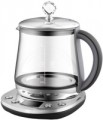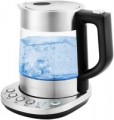Type
—
Electric kettle.Electric kettles are traditional water heating containers that come with built-in heaters. Unlike thermopots (which are designed to maintain the temperature of the liquid), electric kettles are primarily intended for boiling water and do not have advanced temperature control features.
—
Thermopot. Thermopots are hybrid devices that incorporate features of both electric kettles and thermoses. They have thick walls, often double-layered, and a tighter lid, which provides improved thermal insulation compared to traditional electric kettles. Additionally, they typically have a built-in pump for dispensing water. The primary advantage of a thermopot is its ability to both heat water and maintain its temperature for an extended period, thanks to the enhanced insulation. This makes them ideal for situations where a constant supply of hot water is needed. However, they are slower to heat water compared to regular electric kettles, so it's essential to plan ahead.
—
Hot water dispenser. A kind of kettles, outwardly similar to thermo pots, but according to the principle of operation, it resembles the “hot water” function in
coffee machines. The dispenser is designed to store water and does not have a built-in heater. Instead, the heating process occurs when water is dispensed, resulting in hot water being availabl
...e within seconds. This process is energy-efficient since only the volume of water dispensed is heated. Dispensers usually offer a range of temperature controls, and some models allow for a predetermined amount of hot water to be dispensed. However, the main drawback of these devices is their relatively high cost.
— Brewing.These are kettles that are specifically designed for brewing tea and other beverages. They feature a strainer or a similar device for steeping tea leaves or herbs. Many of these models come equipped with a thermostat, which makes it easy to select the ideal brewing temperature for different types of tea. Glass is the preferred material for the body of such kettles, often in combination with metal, as it allows for monitoring the brewing process, controlling the colour and transparency of the contents, while not affecting the taste or aroma of the beverage. These kettles can also be used to heat water for other purposes, by simply removing the strainer or leaving it empty.
— Brewing kit. A hot drink preparation kit that includes two separate vessels, a kettle and a teapot. The kettle is used to heat water, while the teapot may not have a built-in heater and can be a traditional vessel. This option may be more suitable for certain types of tea that require immediate infusion with hot water. However, two-piece sets tend to be heavier, larger, and more costly than multipurpose kettles with brewing capabilities, which makes them less popular nowadays.
It's worth mentioning that samovars in the form of electric kettles are also considered brewing kits, but they have unique features that distinguish them from other types and warrant their classification as a separate category (see below).
— For brewing coffee. Kettles with an elegant "swan neck" design feature a thin, curved S-shaped spout that allows for precise pouring of water. Some models for making coffee also have the ability to control the water temperature accurately. This allows for a gradual and even supply of hot water through the spout, resulting in a well-extracted coffee during the brewing process. These kettles are also suitable for making certain types of tea that require precise temperature control during preparation.
— Samovar. Electric samovars are modern devices designed to imitate traditional samovars. These models usually have a retro design (see "Design"), but there are also original-looking devices within this style. Typically, an electric samovar consists of a main vessel for heating water and a teapot, which is placed on top of the main vessel and is heated by its heat. While electric samovars are functional, they are bulkier and more expensive than regular electric kettles. As a result, they are not commonly produced and are mainly aimed at enthusiasts of antique items and those who enjoy unique kitchen accessories.Volume
The nominal capacity of a kettle refers to the maximum amount of water that can be safely poured into it, and it is typically indicated by the water level indicator. In the case of brewing sets (see "Type"), the nominal capacity refers to the main kettle, while the capacity of the teapot is listed separately (see below).
The capacity of the electric kettle directly affects the amount of water that can be heated at once. A larger capacity allows for heating more water, but this also means the kettle will be larger and heavier. Additionally, heating a larger volume of water requires either more power or a longer time. Therefore, it is important to consider one's actual needs when choosing a kettle based on its capacity. For example,
mini-kettles for travelling (or for one person) have a volume of up to 1 liter. For home use in a family of 2 – 3 people, a 1,5 – 2 liter model is enough. Devices for
2 – 3 liters are already well suited for a small office or a similar situation. The most spacious electric kettles are designed to hold 10 liters or more, and are typically used in public places such as canteens and cafes for dispensing hot water.
Power consumption
The power consumed by the kettle during operation is actually the power of the heating element installed in the device.
Two working moments depend on this parameter: heating intensity and electricity consumption. On the one hand, the
high power of the heater allows you to quickly heat up a certain volume of water and saves time. On the other hand, the power consumption of such a device will also be appropriate. The wattage of a kettle's heater typically does not have a significant impact on electricity bills since the energy consumption required to heat a given volume of water remains the same regardless of the heater's power rating. However, there may be certain issues related to electrical connectivity. For example, if the wiring is weak or the fuses are improperly sized, the operation of a high-power heater may cause power outages. Additionally, devices with a power rating greater than 3500 W cannot be connected to a regular electrical outlet and require a specific power format. Consequently, even the largest thermal pots, which typically have a capacity of 10 L or more, are rarely equipped with heaters more powerful than 3000 W, since this power rating is sufficient for their intended use and can be connected to a standard electrical outlet.
Temperature adjustment
The temperature adjustment capabilities refer to the specific temperature values that can be programmed into the electric kettle. It's important to note that this refers to automatic adjustment, where the kettle turns off or switches to temperature maintenance mode once the desired temperature has been reached.
If this paragraph contains several options separated by commas (for example, “60 °С, 80 °С, 90 °С”), this means that this model has several fixed temperature options. However, there are also devices with
smooth adjustment, which allows you to adjust the temperature in steps of 5 °C, or even 1 °C; for such devices, the entire adjustment range is indicated here, for example, "60 — 100 °C".
The greater the number of temperature setting options available in an electric kettle, the more versatile it becomes, allowing for precise selection of the optimal brewing mode for various types of drinks. Here is a simple table of recommended temperatures:
—
white tea — 60 °C;
—
yellow tea -70 °C;
—
green tea — 80 °C;
—
black tea — 90 °C;
— rooibos, hibiscus — 100 °C (up to boiling);
—
baby food — 40 °C.
Of course, there are exceptions to such rules — depending on the specific type of drink. For example, some
...varieties of green tea can be brewed at 90 °C.Thermometer
A device that displays the temperature of the water in the kettle. The presence of a
thermometer is useful if the water needs to be heated to a certain temperature. However, the thermometer does not automatically turn off the kettle, unlike a thermostat — this must be done manually. Also, the thermometer allows you to assess how much the heated water has cooled over time and whether it can be used without heating again.
Delay start timer
A function that allows you to pre-set
the start time of the kettle. For example, you can pour water in the evening and set a timer for the morning, so that by the time you woke up, it has just boiled. This eliminates the need to turn on the kettle manually and wait for the water to heat up.
Removable lid
The ability to completely remove the lid of the kettle. Such a possibility is not of particular importance during regular use, however, it provides additional convenience if the kettle needs to be washed from the inside — a
removable lid, unlike a traditional non-removable one, will not hang on the fixture, hit your hands and create other discomforts. On the other hand, there is a certain risk of losing this lid, so this feature is not common.
Opening the lid with a button
Kettles (see "Type") in which the lid opens at the touch of a button. This opening is faster and more convenient, and often safer than the traditional way (grab the lid and pull it up): the lid can get quite hot when the kettle is in operation, and long contact with it is fraught with burns. And although the button can also be placed on the lid, a short press is enough to activate it, and even in such cases the risk of getting burned is minimal. On the other hand,
opening the lid with a button complicates the design of the kettle and reduces its reliability.
Backlight
Decorative lighting of the body or capacity of the kettle. It has mainly aesthetic value — it improves the appearance of the device. Sometimes it can serve as a kind of indicator, for example, change the colour when water is boiling.

